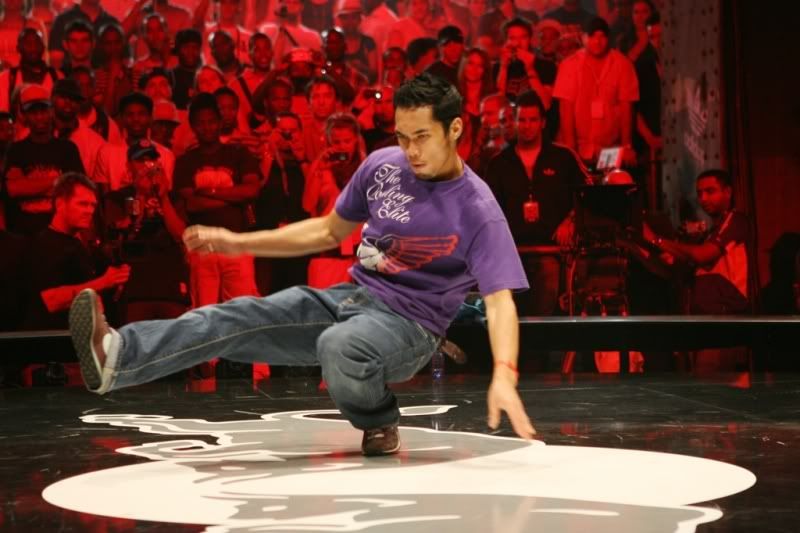 Ten years ago the style was a lot more simple and comfortable, regular sweat pants, a [usually] oversized t-shirt, either a hat or a bandana, and comfortable shoes. (since they're on bboys/bgirls are on their feet most of the time) Not only do many bboy/bgirl moves require strength, but they require a movement that cannot be hindered because of clothes. Battling, a head to head confrontation between individuals or groups of bboys/bgirls who try to out dance each other, is an integral part of the bboy/bgirl culture. One cannot afford to lose, because their clothes are too tight and end up hurting in the process.
Ten years ago the style was a lot more simple and comfortable, regular sweat pants, a [usually] oversized t-shirt, either a hat or a bandana, and comfortable shoes. (since they're on bboys/bgirls are on their feet most of the time) Not only do many bboy/bgirl moves require strength, but they require a movement that cannot be hindered because of clothes. Battling, a head to head confrontation between individuals or groups of bboys/bgirls who try to out dance each other, is an integral part of the bboy/bgirl culture. One cannot afford to lose, because their clothes are too tight and end up hurting in the process.
But with the recent popularity of bboying (now termed "breakdancing" by the media), it is clear WHY the styles have changed. Now that the art is being put into the limelight more, there was the demand to be more "fashionable". So many of the bboys have resorted to ball-suffocating jeans, Nike dunks, and very urban, hip hop-esque t-shirts. Though it is nice to see bboy clothing change throughout the years, I do miss the parachute pants.
I always thought bboying/bgirling was an Asian thing... back when I was 10 years old! After growing up and doing my research, the hip hop culture was more of African-American based. Maira mentions a young man named Darmesh recalling that "Indian American youth who grew up with Blacks and Latinos, and even some who did not, often perform or acquire 'the style, and the attitude, and the walk' associated with [hip hop culture] youth..." (265). Like Indian American youth, the young men I grew up with (aka my uncles) that taught me this element of the hip-hop culture, turned to hip hop to get away from the struggles that is bound with being an alien in the United States (Maira 268). Coming straight from the Philippines, my uncles had a hard time fitting in and turned to the bboying scene introduced to them by their other Filipino friends. Not only did they get into bboying, they began dressing like a bboy too with the baggy sweat pants and oversized t-shirt. Although they have grown up and are now young professionals, I still see their bboy roots incorporated into their style.
Christine Erfe blog #6
Resources:
Maira, Sunaina. Henna and Hip Hop: The Politics of Cultural Production and the Work of Cultural Studies. Class reader.
No comments:
Post a Comment